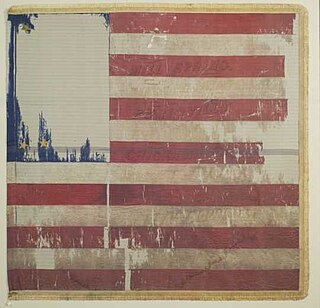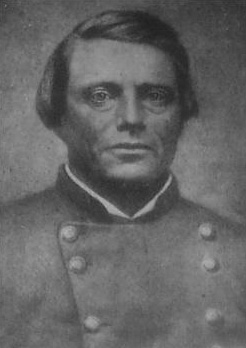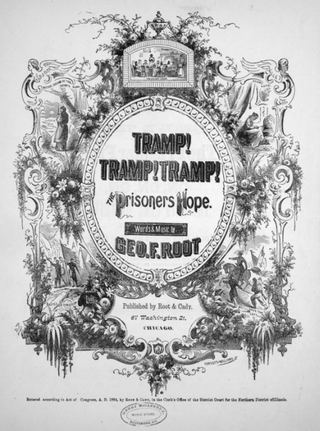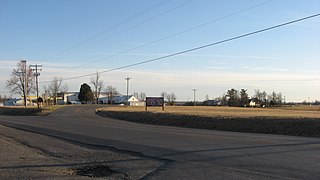
Albert Sidney Johnston was an American military officer who served as a general in three different armies: the Texian Army, the United States Army, and the Confederate States Army. He saw extensive combat during his 34-year military career, fighting actions in the Black Hawk War, the Texas-Indian Wars, the Mexican–American War, the Utah War, and the American Civil War.

Braxton Bragg was an American army officer during the Second Seminole War and Mexican–American War and Confederate general in the Confederate Army during the American Civil War, serving in the Western Theater. His most important role was as commander of the Army of Mississippi, later renamed the Army of Tennessee, from June 1862 until December 1863.

The Battle of Stones River, also known as the Second Battle of Murfreesboro, was fought from December 31, 1862, to January 2, 1863, in Middle Tennessee, as the culmination of the Stones River Campaign in the Western Theater of the American Civil War. Of the major battles of the war, Stones River had the highest percentage of casualties on both sides. The battle ended in Union victory after the Confederate army's withdrawal on January 3, largely due to a series of tactical miscalculations by Confederate Gen. Braxton Bragg, but the victory was costly for the Union army. Nevertheless, it was an important victory for the Union because it provided a much-needed boost in morale after the Union's recent defeat at Fredericksburg and also reinforced President Abraham Lincoln's foundation for issuing the Emancipation Proclamation, which ultimately discouraged European powers from intervening on the Confederacy's behalf.

A battle cry or war cry is a yell or chant taken up in battle, usually by members of the same combatant group. Battle cries are not necessarily articulate, although they often aim to invoke patriotic or religious sentiment. Their purpose is a combination of arousing aggression and esprit de corps on one's own side and causing intimidation on the hostile side. Battle cries are a universal form of display behaviour aiming at competitive advantage, ideally by overstating one's own aggressive potential to a point where the enemy prefers to avoid confrontation altogether and opts to flee. In order to overstate one's potential for aggression, battle cries need to be as loud as possible, and have historically often been amplified by acoustic devices such as horns, drums, conches, carnyxes, bagpipes, bugles, etc..

The "Battle Cry of Freedom", also known as "Rally 'Round the Flag", is a song written in 1862 by American composer George Frederick Root (1820–1895) during the American Civil War. A patriotic song advocating the causes of Unionism and abolitionism, it became so popular that composer H. L. Schreiner and lyricist W. H. Barnes adapted it for the Confederacy.

"God Save the South" is a poem-turned-song considered by some to have been the unofficial national anthem of the Confederate States of America. The words were written in 1861 by George Henry Miles, under the pen name Earnest Halphin. It was most commonly performed to a tune by Charles Wolfgang Amadeus Ellerbrock, although a second version was also published with a tune by C. T. De Cœniél.
Ululation, is a long, wavering, high-pitched vocal sound resembling a howl with a trilling quality. It is produced by emitting a high pitched loud voice accompanied with a rapid back and forth movement of the tongue and the uvula.
The rebel yell was a battle cry used by Confederate soldiers during the American Civil War.

The 2nd Minnesota Infantry Regiment was a Minnesota USV infantry regiment that served in the Union Army during the American Civil War. The regiment went on to campaign in the south and especially distinguish itself at the battles of Mill Springs, Chickamauga, and Missionary Ridge.

Jean-Jacques-Alfred-Alexandre "Alfred" Mouton was a Confederate general in the American Civil War. Although trained at West Point, he soon resigned his commission to become a civil engineer and then a sugarcane grower, while also serving as a brigadier general in the Louisiana State Militia.

Thomas Green was an American soldier and lawyer, who took part in the Texan Revolution of 1835–36, serving under Sam Houston, who rewarded him with a land grant. Green was clerk of the Texas Supreme Court until the outbreak of the Civil War, when he became a Confederate cavalry leader. After winning several victories, including the Battle of Valverde and the recapture of Galveston, he was promoted brigadier and assigned command of the cavalry division of the Trans-Mississippi Department. In the Red River Campaign, he was mortally wounded while charging a fleet of Federal gunboats. The Union naval commander David Dixon Porter paid tribute to Green as a serious loss to the Confederacy.

During the American Civil War (1861–1865), Maryland, a slave state, was one of the border states, straddling the South and North. Despite some popular support for the cause of the Confederate States of America, Maryland did not secede during the Civil War. Governor Thomas H. Hicks, despite his early sympathies for the South, helped prevent the state from seceding.
The 23rd Iowa Infantry Regiment was an infantry regiment that served in the Union Army during the American Civil War.
Historiography examines how the past has been viewed or interpreted. Historiographic issues about the American Civil War include the name of the war, the origins or causes of the war, and President Abraham Lincoln's views and goals regarding slavery.

African Americans, including former slaves, served in the American Civil War. The 186,097 black men who joined the Union Army included 7,122 officers and 178,975 enlisted soldiers. Approximately 20,000 black sailors served in the Union Navy and formed a large percentage of many ships' crews. Later in the war, many regiments were recruited and organized as the United States Colored Troops, which reinforced the Northern forces substantially during the conflict's last two years. Both Northern Free Negro and Southern runaway slaves joined the fight. Throughout the course of the war, black soldiers served in forty major battles and hundreds of more minor skirmishes; sixteen African Americans received the Medal of Honor.

"Tramp! Tramp! Tramp! " was one of the most popular songs of the American Civil War. George F. Root wrote both the words and music and published it in 1864 to give hope to the Union prisoners of war. The song is written from the prisoner's point of view. The chorus tells his fellow prisoners that hope is coming. A Confederate version and various other versions have been made.

During the American Civil War, music played a prominent role on each side of the conflict, Union and Confederate. On the battlefield, different instruments including bugles, drums, and fifes were played to issue marching orders or sometimes simply to boost the morale of one's fellow soldiers. Singing was also employed not only as a recreational activity but as a release from the inevitable tensions that come with fighting in a war. In camp, music was a diversion away from the bloodshed, helping the soldiers deal with homesickness and boredom. Soldiers of both sides often engaged in recreation with musical instruments, and when the opposing armies were near each other, sometimes the bands from both sides of the conflict played against each other on the night before a battle.
Confederate monuments and memorials in the United States include public displays and symbols of the Confederate States of America (CSA), Confederate leaders, or Confederate soldiers of the American Civil War. Many monuments and memorials have been or will be removed under great controversy. Part of the commemoration of the American Civil War, these symbols include monuments and statues, flags, holidays and other observances, and the names of schools, roads, parks, bridges, buildings, counties, cities, lakes, dams, military bases, and other public structures. In a December 2018 special report, Smithsonian Magazine stated, "over the past ten years, taxpayers have directed at least $40 million to Confederate monuments—statues, homes, parks, museums, libraries, and cemeteries—and to Confederate heritage organizations."
Here's your mule or Where's my mule? was a Confederate catch phrase during the Civil War, often noted in Civil War histories. It resulted in several Civil War songs, including "Here's Your Mule", "How Are You? John Morgan", and "Turchin's Got Your Mule". It is also credited with contributing to General Bragg's failure to rally his troops at Missionary Ridge.

The Battle of Sacramento was an engagement of the American Civil War that took place in Sacramento, Kentucky on December 28, 1861. Confederate cavalry under Colonel Nathan Bedford Forrest, numbering between 200 and 300, attacked, encircled and defeated a Union force of 500 under Major Eli H. Murray which had been watering south of the town after moving across the bank of the Green River. Though exact casualty information is disputed, with differing accounts from each side, several eyewitnesses attested to the personal courage of Forrest, and the Confederate commander was praised by his superiors for his bravery.














